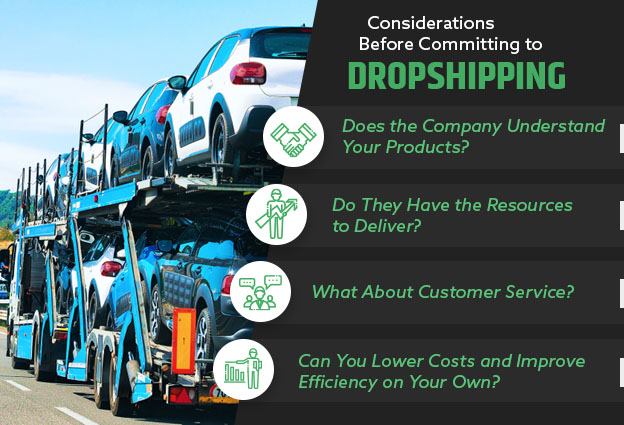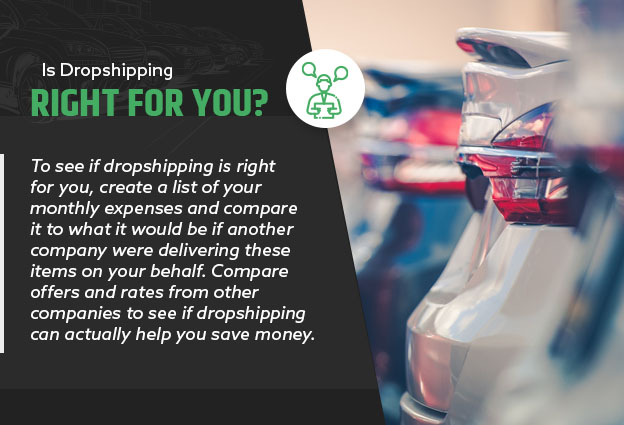The automotive industry continues to evolve in the age of the internet. Consumers used to buy their cars right off the lot, but more people are starting to purchase vehicles on their phone or laptop. Recent statistics show car shoppers tend to do a lot of research online before making their final decision so they might as well complete their order with just a few clicks. From specialty parts and accessories to new and used models, drivers prefer the convenience of online shopping.
As an automotive retailer or manufacturer, you can take advantage of this trend by implementing what’s known as “dropshipping” into your business model. Instead of managing the inventory and fulfilling orders onsite, dropshipping means handing off your products to a third-party so they can fulfill orders on your behalf. This can help you save money, improve efficiency and free up more of your time so you can focus on other aspects of your business.
Use Metal Storage Containers to Protect Your Product
But this business model isn’t for everyone or every industry. Find out if dropshipping is worth it.
What Is Dropshipping?
If you’re used to selling your products online, dropshipping essentially gets rid of the order fulfillment process–at least on your end. Instead of managing a warehouse and preparing your products for shipment, a third-party will manufacture and distribute these products for you. This is considered a “hands-off” approach to order management. You can still control the flow of your products, but you won’t be in the room where it happens.
In most cases, you will pay the third-party a monthly rate for their services, including the manufacturing, sorting, storage and distribution of your products. You can then sit back and make a profit off each order without having to lift a finger–minus the cost of dropshipping.
Benefits
The benefits for dropshipping are clear. You won’t have as much control over the flow of your products, but you won’t have to worry about the high cost of renting and managing a warehouse or opening a brick-and-mortar retail store. It usually costs around $0.85 per square foot per month to rent and operate a warehousing facility, but the true cost may catch you off guard after you add up all the utilities, maintenance, labor and transportation costs.
You can sit at home or the office while a third-party moves your inventory from point A to point B and everywhere in between. This gives you the freedom to grow and develop your business without having to focus on the nitty gritty details of warehouse management. You can spend more time on marketing, developing your contacts, wooing potential investors or improving your customer service.
If you have yet to get your automotive business off the ground, dropshipping dramatically reduces the barrier to entry. Once you find a reliable third-party to manage your inventory, you can quickly get your business off the ground without a significant financial investment. As long as you continue to sell products online, both you and the third-party should be able to make a profit.
Disadvantages
If you prefer to micromanage your business, dropshipping may not be the right choice for you. Hiring a third-party to manufacture and deliver your products gives you less oversight over the entire process. As a client, you can still direct the third-party from afar, but it’s not the same as directly overseeing the manufacturing and distribution process.
Pallet Containers Help Keep the Warehouse Organized and Operating
This could lead to problems down the line, such as product recalls, unexpected delays, poor customer service and surprise costs–especially if you and your dropshipper aren’t on the same page. Dropshipping essentially means trusting another company to deliver the goods. If you’re not comfortable with this idea, it’s best to manufacture and distribute your products onsite.
Things to Consider for the Automotive Industry
Of course, dropshipping isn’t right for everyone. It all depends on your existing business model and how you plan on moving your products to the end user. Keep these considerations in mind before committing one way or another.
Does the Company Understand Your Products?
You shouldn’t invest in dropshipping unless you can find a reliable third-party that understands your products. This may be a challenge in the automotive industry. Delivering and manufacturing vehicles isn’t the same as shipping out a toaster oven. These are complicated pieces of machinery, so finding a dropshipper that knows their way around under the hood may be a tall order.
You will have to trust this party to manufacture your products according to specific guidelines, especially if your business is known for selling unique or custom auto parts or vehicles. As a business owner, you’ve spent years developing your brand so you need to make sure the dropshipper can continue that legacy.
Look for a company with experience fulfilling and manufacturing orders in the automobile industry. They should be familiar with the equipment used in the industry, how these vehicles work and what makes them different from other models on the road.
This may not be important if you plan on selling and distributing pre-existing products, such as those from a major auto manufacturer. In this case, the company will need to find a way to store and maintain your inventory instead of manufacturing it outright.
Do They Have the Resources to Deliver?
Many dropshipping providers are used to operating in different industries simultaneously. They usually serve a range of clients as they ship off everything from consumer electronics to food. However, the automotive industry requires special considerations. Your products will likely be quite large and cumbersome. Today’s vehicles also contain somewhere around 30,000 individual parts.
So, you’ll need to ask yourself if the dropshipper can hold up their end of the bargain. There are lots of eCommerce partners out there waiting to take your money, but they may not have the resources to follow through. Consider how the company will manufacture, store and distribute your merchandise, including all the smaller components that go into these machines. For example, the company should use metal storage bins or totes to organize all these different parts.
It may be best to go with an automated dropshipping company. Today, most vehicles are made on factory lines with minimal human involvement. The company should be able to streamline the manufacturing process to avoid any unnecessary delays. Automating the process also reduces the chances of workplace accidents and other mishaps that could derail your business.
You should also consider the demand for your products, including any seasonal fluctuations that may impact your business model. Share your order records with the dropshipping company to give them an accurate idea of how demand tends to fluctuate from month to month. This will help them prepare for a sudden flood of orders so your customers can still access the products they need.
What About Customer Service?
Your customers should be your first priority when considering the dropshipping method. Handing your products over to another company may hurt or help your shoppers. It all depends on the company in question. Some dropshippers have the resources to speed up the delivery timeline, meaning your customers don’t have to wait as long to receive their orders. They may use a network of distribution outlets to quickly move your products all over the country or abroad.
However, some dropshippers may put the customer at a disadvantage. The company could fall behind on orders if they get hit with an unexpected delay in production. Some third-party companies may bite off more than they can chew, damaging your reputation in the process.
You also have to think about how you will respond to questions and comments about your products–whether online or in person. Remember that you won’t be in the room with your products when you take the call, so you’ll need to figure out a way to coordinate with the dropshipper in real-time. This way, you can both work together to answer the customer’s question.
Can You Lower Costs and Improve Efficiency on Your Own?
Dropshipping is a great way to save money and simplify your operating expenses. Without a warehouse to worry about, you can focus on promoting your company and improving your relationships with your business partners.
But dropshipping isn’t the only way to save money, especially in the automotive industry. Handing your products off to a third-party essentially removes you from the equation. You will have to trust the dropshipper to manufacture and distribute your products as quickly and as cheaply as possible instead of managing these processes in person.
Look for ways to simplify the manufacturing and order fulfillment process on your own before committing to dropshipping. If the cost of shipping is taking a toll on your business, find ways to reduce your costs without putting your products at risk.
Plastic totes are great for arranging individual parts and tools on the shelf. They come with open slats so your workers can still see what’s inside. This will help your employees make sense of all your inventory and they can quickly pick up the item they need and be on their way without having to sort through dozens of similar-looking containers.
Use a pallet container to move and store large quantities of auto parts and other supplies. These containers are lightweight and durable enough to keep your products safe, while reducing your shipping expenses. They also lock together for efficient stacking. This makes it easy to move several containers at once without having your team lift boxes by hand.
To simplify the loading and unloading process, choose between traditional pallets and skid plates. If you’re not sure what a skid is in shipping, they are just like a pallet except without the bottom layer. While they tend to be cheaper than regular pallets, they may not be as stable.
Consider all the factors that influence international shipping costs and look for ways to move your products closer to the consumer to reduce the delivery timeline. Try partnering with local businesses to find ways to store your products at a variety of locations. For example, you can rent a few parking spots at a local business if it means you can deliver your products to the consumer at a fraction of the cost it would be to ship them from one centralized location.
Compiling the Total Costs
To see if dropshipping is right for you, create a list of your monthly expenses and compare it to what it would be if another company were delivering these items on your behalf. Compare offers and rates from other companies to see if dropshipping can actually help you save money. Make sure this list is accurate and don’t forget to include the tips mentioned above to reduce your shipping and manufacturing costs onsite.
When talking to potential dropshippers, ask about additional benefits or incentives that may sweeten the deal, such as automatic pickers and stockers for improving efficiency, electric vehicles for reducing your carbon footprint or a smooth return policy.
If you can save money and still deliver your products to your consumers, dropshipping may be the right choice for your business.
Once you have a perspective on dropshipping in eCommerce, you can start implementing this idea into your business model. Be selective with potential service providers to make sure they will help you reach your goals. Ultimately, this decision should help you get more products out the door in less time and for less money. If not, you’re better off manufacturing your products yourself.
Keep these ideas in mind to make the right decision for your business.






